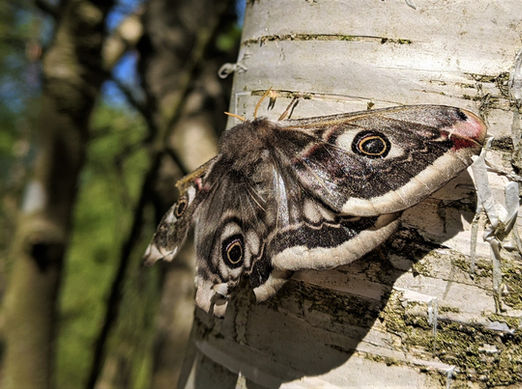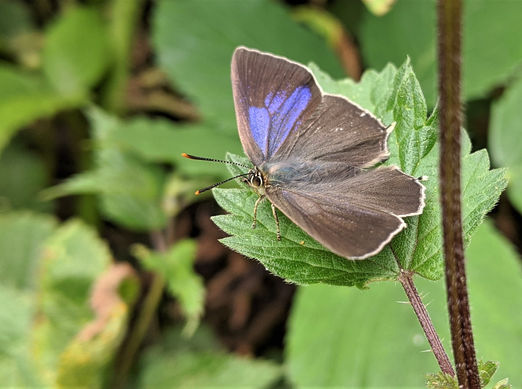Nature
Courtesy of Gary Kerfoot, David Buttle, Andrew Hill and Robert Bell
Habitats
Vegetation comprises heather-dominated (intermediate level) dry dwarf shrub heath with adjacent secondary oak/birch scrub and mixed plantation woodland, some of which comprises replanted ancient semi-natural woodland. Other habitat-types include establishing wood-pasture, stream-sides and two ponds (with submerged and emergent vegetation and bankside alder and oak trees).
The heath is the most extensive tract of intermediate level heathland in the Sheffield region and grows on a well-drained, boulder-strewn sandy podzol. The main area of heather stretches for nearly a kilometre from the northern end of the crags as far as the north-western corner of Wharncliffe Chase where it narrows and extends for some distance along the crag edge. Heathland grades into scrub woodland in the valley bottom. Areas of heath have been invaded by bracken. Close to the stream at the eastern margin of the heath is a developing area of wood pasture with scattered sessile oaks and silver birch.
The heath is bordered in the east by a strip of deciduous, mixed and plantation woodland with some standing and fallen dead wood and a number of mature trees including some large mature oak, sweet chestnut and beech. Much of this area supports a range of ancient woodland indicator species such as great wood-rush, wood sorrel and broad-leaved helleborine, with a good display of bluebells showing in the spring. North of the heath, birch woodland and patches of open heather finally grade into mature oak/birch/sycamore woodland. The stream from the heath continues through this woodland, its banks dominated by a mixture of alder, holly and oak.
The western side of the heath comprises the top of Wharncliffe Crags rock face, with a boulder field of predominantly exposed rock with partial heather and bracken cover, grading into oak-birch woodland which is cut through by a high voltage overhead pylon line.
Two ponds are present within the reserve, including the larger 0.15ha dam pond at the northern end of the reserve, which has a little submerged or emergent vegetation with fringing trees. The smaller and more recently constructed grazing pond is present within wood pasture on the eastern end of the heath, and resembles a typical acid heathland pond, with sphagnum moss surrounding the water body. Both water bodies have good water quality and are slightly acidic, with more information on water quality available here.
A full species list for the reserve can be found here.
Birds
In 2019 the reserve had been subject to eleven consecutive years of breeding bird survey, and the final nest boxes of a box scheme totaling more 350 boxes will be installed in winter 2020/2021.
Pied flycatchers first bred on site in 2015, with eight territories present in summer 2020. The heathland really comes alive in the summer with heathland bird species including tree pipit, and linnet breeding on site and nightjar present every year. The woodland is also known to support a high density of breeding woodcock with breeding cuckoo also present.
As a result of the box scheme the number of nuthatch holding territories on site increased from 0 in 1999 to 12 in 2020, with blue tit territories jumping from 1 in 1999 to 76 in 2020 and great tits showing a similar increase. The latest bird survey report for the site can be read here.
Mammals
Roe deer, brown hare and badger are known to use the site, however amongst mammals the site is best known for bats. Eight of South Yorkshire’s ten bat species have been recorded using the reserve with six species recorded using the site’s bat box scheme. The 75 box scheme, run in partnership with South Yorkshire Bat Group, is the largest and most well established box scheme in the county and is used by breeding Natterer’s bats together with a relatively large aggregation of noctule bats during autumn and winter.
Courtesy of Gary Kerfoot, Robert Bell and Andrew Hill
Amphibians and reptiles
The dam pond is noted for the large colony of palmate newt, alongside common toad and common frog with more than 500 palmate newt making use of this waterbody. Sheltered sunny banks and bracken beds provide excellent basking sites for reptiles with the tall heathland vegetation providing cover for the populations of common lizard and grass snake which are quite regularly encountered on site.
Invertebrates
The Wharncliffe Wood area has been well researched for its invertebrate fauna during the past three decades and the invertebrate interest of the heath is expected to be high; local species include the scarce green hairstreak butterfly and several indicators of ancient woodland (including hoverflies and other species). Green tiger beetle and emperor moth occur on the heath. The dam pond supports strong common and southern hawker dragonfly populations.
Courtesy of Gary Kerfoot, Patrick Fitzsimons and Robert Bell

















